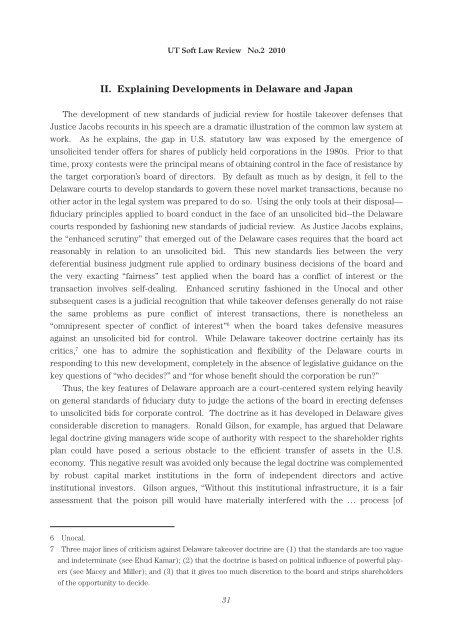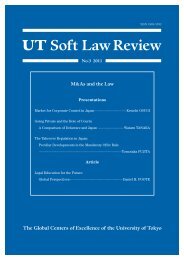UT Soft Law Review
UT Soft Law Review
UT Soft Law Review
You also want an ePaper? Increase the reach of your titles
YUMPU automatically turns print PDFs into web optimized ePapers that Google loves.
<strong>UT</strong> <strong>Soft</strong> <strong>Law</strong> <strong>Review</strong> No.2 2010II. Explaining Developments in Delaware and JapanThe development of new standards of judicial review for hostile takeover defenses thatJustice Jacobs recounts in his speech are a dramatic illustration of the common law system atwork. As he explains, the gap in U.S. statutory law was exposed by the emergence ofunsolicited tender offers for shares of publicly held corporations in the 1980s. Prior to thattime, proxy contests were the principal means of obtaining control in the face of resistance bythe target corporation’s board of directors. By default as much as by design, it fell to theDelaware courts to develop standards to govern these novel market transactions, because noother actor in the legal system was prepared to do so. Using the only tools at their disposal—fiduciary principles applied to board conduct in the face of an unsolicited bid--the Delawarecourts responded by fashioning new standards of judicial review. As Justice Jacobs explains,the “enhanced scrutiny” that emerged out of the Delaware cases requires that the board actreasonably in relation to an unsolicited bid. This new standards lies between the verydeferential business judgment rule applied to ordinary business decisions of the board andthe very exacting “fairness” test applied when the board has a conflict of interest or thetransaction involves self-dealing. Enhanced scrutiny fashioned in the Unocal and othersubsequent cases is a judicial recognition that while takeover defenses generally do not raisethe same problems as pure conflict of interest transactions, there is nonetheless an“omnipresent specter of conflict of interest” 6 when the board takes defensive measuresagainst an unsolicited bid for control. While Delaware takeover doctrine certainly has itscritics, 7 one has to admire the sophistication and flexibility of the Delaware courts inresponding to this new development, completely in the absence of legislative guidance on thekey questions of “who decides?” and “for whose benefit should the corporation be run?”Thus, the key features of Delaware approach are a court-centered system relying heavilyon general standards of fiduciary duty to judge the actions of the board in erecting defensesto unsolicited bids for corporate control. The doctrine as it has developed in Delaware givesconsiderable discretion to managers. Ronald Gilson, for example, has argued that Delawarelegal doctrine giving managers wide scope of authority with respect to the shareholder rightsplan could have posed a serious obstacle to the efficient transfer of assets in the U.S.economy. This negative result was avoided only because the legal doctrine was complementedby robust capital market institutions in the form of independent directors and activeinstitutional investors. Gilson argues, “Without this institutional infrastructure, it is a fairassessment that the poison pill would have materially interfered with the … process [of6 Unocal.7 Three major lines of criticism against Delaware takeover doctrine are (1) that the standards are too vagueand indeterminate (see Ehud Kamar); (2) that the doctrine is based on political influence of powerful players(see Macey and Miller); and (3) that it gives too much discretion to the board and strips shareholdersof the opportunity to decide.31





